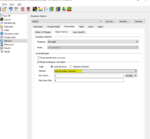Freestylesoap
Member level 3
I simulated a spiral inductor with ADS EM Momentum and would like to look for its dc resistance.
Can I get the dc resistance of this EM-simulated-inductor from its S2P file?
Or since I have the EM model, could I set up a simple circuit as blow to get dc resistance? With a dc source Vdc and a current probe, can I do Rdc=Vdc/I?
Does anyone have suggestions?

Can I get the dc resistance of this EM-simulated-inductor from its S2P file?
Or since I have the EM model, could I set up a simple circuit as blow to get dc resistance? With a dc source Vdc and a current probe, can I do Rdc=Vdc/I?
Does anyone have suggestions?




